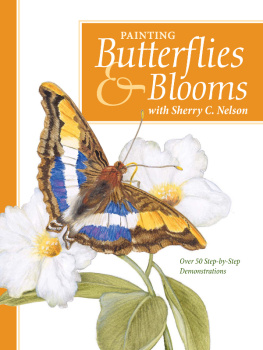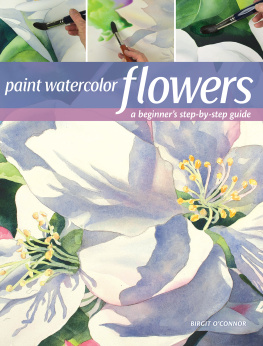Contents
Guide
Painting
Imaginary
Flowers
Beautiful Blooms and Abstract
Patterns In Mixed Media
SANDRINE PELISSIER

artistsnetwork.com
Contents

In Granada Acrylic and mixed media on canvas
12" 12" (30cm 30cm)
DEDICATION
I would like to dedicate this book to all the artists who choose to live a creative life even if that often involves a bit of financial uncertainty. When your work is your passion, its not work anymoreit becomes fun.
WHAT YOULL NEED
SURFACES
canvas
paper
watercolor paper, 190-lb. (400gsm)
PIGMENTS
acrylic inks
alcohol-based inks
colored pencils or Prismacolor Art Stix
fineliner pen, blue
fluid acrylic paints
full-bodied acrylic paints including white
markers
oil marker or paint pen
watercolor paints
BRUSHES
brushes, assorted (stiff and medium sized, soft, large and small, flats and rounds, etc.)
OTHER SUPPLIES
acrylic gel medium
box knife or craft knife
brayer
containers for paints and water
Cont pencil
cradled boards
dipping pens
droppers
gel medium, heavy or extra-heavy
masking fluid
pencil
rubbing alcohol
ruler
scissors
spray bottle of water
spray fixative
varnish for water- and oil-based mediums
INTRODUCTION
Who Are You Becoming?
For many years I could not even think about starting a painting project without a reference image. I think this is probably the case for many artists.
Over time, I got frustrated with that approach; it felt like I was always trying to copy a picture. My goal became to paint in a style that was more personala style that would leave space for intuition and imagination. I wanted freedom from reference images!
Confronted with a blank canvas, I was faced with the question of how to start a painting without a reference. My answer was to look for ways to trigger my imagination. Do you already have a method for breathing life into your imagination? My favorite is one I will detail in this book. It consists of painting an abstract background, adding visual textures and looking for shapes in those textures.

The brain doesnt like nonsense or ambiguity. It will try to make sense of any abstract shape you see. Looking at abstract patterns, your imagination will make you see things like flowers, objects, people, animals, monsters and underwater scenes. It happens automatically without any effort. This is why, without even trying to do so, you might see faces or animals appear when looking at a stuccoed wall. Its also why the Rorschach test is used in psychology to get patients to see things in inkblots and make up stories.
This book is about making flower paintings, but you could use the same techniques to paint any kind of subject. In the last part of the book, I will show you how I apply some of these techniques to landscape paintings.
I hope you will enjoy this book and discover that painting from imagination leads you to a more personal, intuitive and satisfactory way of expressing yourself in your paintings, all while having fun and experimenting!
JOIN THE COMMUNITY!
As you work through the book, you may decide it would be nice to have some support from other students just like you. Join the Facebook group Share your art from Sandrine Pelissier online classes and books where you can share your work and see what others are creating.

Working in my North Vancouver studio on a forest painting and applying (on a larger scale) some of the techniques you will learn in this book.
Gathering Materials
Surfaces for Painting // Demonstration: Mounting Yupo Paper onto Board // Mediums You Can Use // Making Art Is Fun, So Enjoy the Process

In Boston Acrylic and mixed media on canvas
12" 12" (30cm 30cm)
Surfaces for Painting
There are many surfaces you can choose to paint on. My favorites are canvas and Yupo paper mounted onto board. Even if you already have a favorite surface, experiment with new ones once in a while to see what effect a different surface has on the way the paint behaves and on the finished look of the painting.

Unstretched raw canvas
Try painting on unstretched canvas. Some painters dont mind painting on a piece of canvas that is flat on a table while others prefer to first stretch the canvas on stretcher bars, which provides spring and tautness. You may decide to paint on it unstretched and have it stretched only if you are pleased with your painting. One advantage of working on unstretched canvas is that you can easily stack and store your paintings, stretching them only when you want to use them.
Raw canvas requires a coat or two of gesso to prime it prior to painting on it.
CANVAS

Stretched primed canvas
If you choose stretched canvas that has already been primed with gesso, you can start painting right away.
My personal preference is to work in a square format; 12" 12" (30cm 30cm) is my preferred size. Occasionally I will work on larger flower paintings, but the vast majority of my paintings are done this size.

Fluid acrylic and alcohol on canvas
Canvas will accept watercolors, acrylics and inks. Due to the woven texture of the canvas, the visual texture of the background is usually subtler, and the colors are less vivid than they are on smooth surfaces like Yupo paper, stone paper or Claybord.
WATERCOLOR PAPER

Watercolor paper and fluid acrylics
You can paint on watercolor paper with fluid acrylics. Bright and vivid colors are often easier to achieve with acrylics and inks than with watercolor paints.
Finished paintings on loose watercolor paper can be framed for protection and display, or you can mount watercolor paper onto a board and varnish the finished work so that it hangs more like a stretched canvas.























